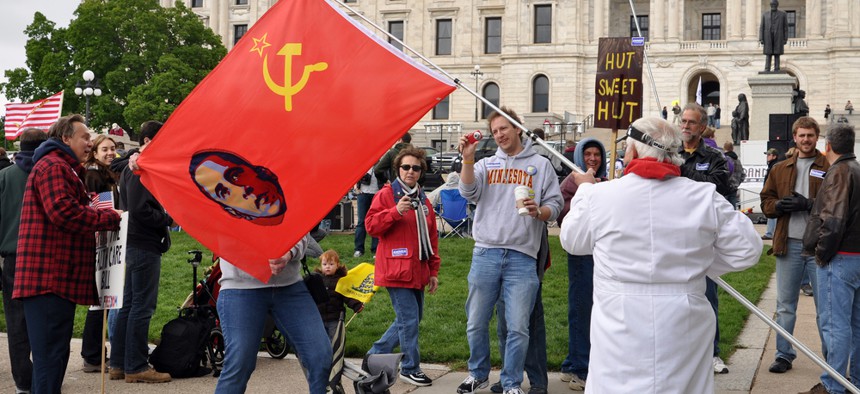
Tea Party protestors rally in St. Paul, Minnesota in 2010. miker/Shutterstock.com
Disruptive Politics
Rising populism is altering the identities of both parties—and scaring the heck out of the establishment.
Back in the mid-1990s, Harvard professor Clayton Christensen coined the phrases "disruptive technology" and "disruptive innovation" to describe certain kinds of game-changing developments in the business world. Now, in politics, we are seeing a variation on that theme.
On the left, the Occupy movement helped spawned a new populism that is reflected in rising interest in Sen. Elizabeth Warren's ideas and future, with her name increasingly being bandied about as a presidential hopeful despite her statements urging Hillary Clinton to run. Warren is fighting banks and other financial institutions in a way that is catching on much more noticeably than the late Sen. Paul Wellstone's tilting at windmills. She's recently made forays into surprising places, touting red-state Senate candidates such as Alison Lundergan Grimes, Mitch McConnell's Democratic challenger in Kentucky, and Natalie Tennant, the Democratic nominee for West Virginia's open Senate seat. Neither would want President Obama to campaign for them, but inviting a Massachusetts Democrat who is considerably more liberal—and more populist—than the president made sense to them.
This isn't just a left-wing phenomenon. Populism fueled the tea-party movement, currently personified by Sens. Ted Cruz and Rand Paul, who both could be serious contenders for the 2016 GOP presidential nomination. This development is causing consternation among old-guard Republicans, who are much more accustomed to fighting Democrats who rail against the established order of things—not fellow Republicans.
The new populist strains spring from the same source: After the financial collapse in 2008, the Troubled Asset Relief Program, proposed and signed into law by Republican President George W. Bush, but passed by Democratic majorities in Congress, triggered both the Occupy and tea-party movements. Even though Occupy has mostly dissipated, the Left's distrust of and anger at the financial sector—and at big business in general—remains alive and well. Similarly, while the tea party is not as visible as it once was, that's partly because it has already succeeded in shifting the Republican Party to the right. GOP elected officials who were long considered pretty conservative are suspect in the new, edgier GOP. So are some of the financial interests that conservatives once faithfully represented.
Are Democrats still the party of labor? Are Republicans still the party of business? It's been a while since either label fit neatly, but the populist surge is further blurring party identities and causing both labor and business to wonder. In corporate boardrooms and business conferences, there's considerable angst over conservative and tea-party opposition to reauthorizing the Export-Import Bank, which has become an important source of funding for overseas sales by large U.S. manufacturers. Meanwhile, Republican establishment types who always considered themselves conservatives are now being called moderates and RINOs—Republicans In Name Only—on conservative websites.
Those who worked in the mid-to-late 1980s and 1990s to bridge the chasm between the business world and the Democratic Party, particularly those instrumental in the creation of the Democratic Leadership Council, also look with chagrin at the increasingly hostile tone toward business coming from the Left. At the same time, stalwarts in the building and construction trade unions wonder about Democrats who oppose the Keystone pipeline for environmental reasons. They also fret over the Obama administration's lack of enthusiasm for infrastructure spending. Franklin Roosevelt, they believe, would be turning over in his grave at the thought that a Democratic president, during a time of severe economic dislocation, did not give construction projects a bigger role in efforts to jump-start the economy.
When you combine them with broad-based anger at Washington, the simultaneously reinvigorated populist movements on the left and right are creating volatility in our political system that has few precedents. This is not just giving establishmentarians headaches; it's also playing havoc with pollsters and strategists who are seeing odd voter-turnout patterns in primary elections such as the one in Virginia's 7th Congressional District (a contributing factor to House Majority Leader Eric Cantor's reelection loss), while in general-election polling, independent and third-party candidates are pulling larger numbers than is normally the case. In North Carolina's Senate race, for instance, Libertarian Sean Haugh, who delivers pizzas for a living, may draw votes from Thom Tillis, the Republican challenger, as well as from Democratic Sen. Kay Hagan; in four recent polls, Haugh has registered 8 percent or more. With both sides pounding their opponents mercilessly with negative advertising, the "pox on both your houses" sentiment seems to be gaining currency all across the country.
Voters are in an ugly and angry mood, and they're behaving differently as a result. Nobody knows exactly what it will ultimately mean, but "disruptive" is certainly a good term for the shifting loyalties and alignments the populist resurgence may bring.
This article appears in the July 19, 2014 edition of National Journal Magazine.
(Image via miker / Shutterstock.com)






